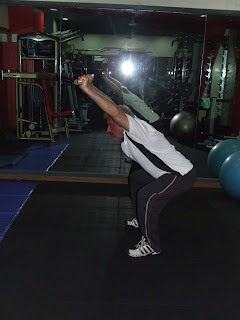You may have heard bodybuilders claim that weight training causes yourmuscle fibers to actually change types. The idea is that by specific weight training, you can help cause muscle fiber changes, which in turn make it easier for future muscle growth.
to actually change types. The idea is that by specific weight training, you can help cause muscle fiber changes, which in turn make it easier for future muscle growth.
The muscles are made up of three major fiber types, I and IIA and IIB(roman numerals standing for type 1 and type 2A and 2B). Type 2 are fast twitch and for power. Type 2 contribute to most muscle growth(hypertrophy). TypeIIB are the most responsive to muscle growth and are colored white unlike the rest, which are red. Type one are slow twitch and mainly for endurance. Type once can still grow in diameter, but it’s not as significant. Each fiber type responds to different types of weights and rep ranges. Type 1 responds best to high reps light weight, whereas type 2 responds best to heavy weight with low reps per set.
The belief is that through training, some of these fiber types, will “act more like”, either a Type 1 or 2 fiber. In addition, you will also stimulate certain muscle fiber types for hypertrophy better than others. In order to do this, you must gear the weight training routine by the weight and reps you use. If you lift heavy with low reps to failure, you should get a increase in proprotion of type 2 fibers.
Muscle Fiber Type Research Studies:
A study published J Gerontol A Biol Sci Med Sci. 2000 Jul;55(7):B336-46 was done on 18 untrained older men. 9 did resistance training, while the other 9 served as a control. They did the resistance training for 16 weeks, 3 sets of leg press, half squat, and leg extension at 6-8 reps to failure with 1-2 minutes rest between sets. The results showed that I, IIA, IIB, fiber types all increased sized significantly. One interesting effect was that the proportion of type IIB fibers decreased and IIA fibers increased. Type IIB are a little more responsive to hypertrophy, but all fiber types hypertrophied, leading to a overall muscle size increase.
Another study published in (Eur J Appl Physiol Occup Physiol. 1990;61(1-2):37-41) was done on 12 college age men, comparing endurance resistance to strength training resistance excercises. One group did 7.5 weeks of muscular strength resistance training(heavy weight low reps), then took 5.5 weeks break, then continued for 7.5 weeks doing the endurance training(high reps lighter weight). The other group first started endurance resistance, then went to strength. The results showed that for the first phase, both types of training increased the fiber size of I, IIA, and IIB. However, the group that did strength phase 2nd, showed a increase in size in the I and IIB fiber types, but the endurance group in the 2nd phase showed decreased size in all fiber types. This study suggests that both types of training increase all fiber type sizes, but switching to endurance training after strength training, will reverse the hypertrophy gains.
Finally the study (Eur J Appl Physiol. 2002 Nov;88(1-2):50-60. Epub 2002 Aug 15.) was done on 32 untrained men for 8 weeks. They were divided into 4 groups (low rep, intermediate rep, high rep, and control). The low rep group did 3-5 reps to failure for 4 sets with 3 minutes rest between sets. Intermediate group did 9-11 reps for 3 sets with 2 minutes of rest. The high rep group did 20-28 reps with one minute rest. The excercises chosen were leg press, squat, and knee extension 2-3 times a week(2 for first 4 weeks, then 3 times a week for final 4 weeks). All muscle fiber types hypertrophied except in the control and high rep group. All groups however, did have a decrease in proportion of IIB fibers and increase in IIAB fibers. IIAB fibers will have less of the ability to increase in size than IIB. This study suggests that the muscle fiber type changes happened equally with all training groups, however the lower rep ranges were most effective at inducing overall hypertrophy. It appears that not even the 3-5 rep group could change the fibers to pure IIB fibers.
These studies show interesting results because it appears the common types of rep ranges bodybuilders do, will not change your muscle fiber to a higher proportion of IIB fibers(the ones most responsive to hypertrophy). It appears you might have to use an extremely heavy weight, one that would cause failure below 4 reps, to have a switchover to more pure IIB fibers. Focusing on only one type (IIB) is not the goal of bodybuilders however, as you would then be neglecting the other fiber types. Using very heavy weights is also hard on the joints and increases risk of injury. Even though there was no switchover to more proportion of IIB fibers in these studies, these more faster twitch fibers(IIB, IIAB, IIA) seemed to respond better to the heavier weights and thefore there was more overall hypertrophy.
Studies have also shown that there is a wide variance in the proportion of Type 2 to type 1 fibers, not only between each muscle, but between individuals. This is one major reason why, some people struggle to gain muscle, while others gain it with almost no effort. This is also why some people are more fit, for strength lifting or sprinting, while others are more suited for running or other endurance activities.






















